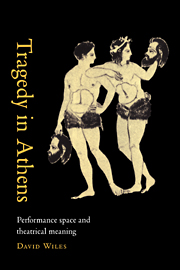Book contents
- Frontmatter
- Contents
- List of illustrations
- Acknowledgements
- List of abbreviations
- 1 The problem of space
- 2 The Theatre of Dionysus
- 3 Focus on the centre point
- 4 The mimetic action of the chorus
- 5 The chorus: its transformation of space
- 6 Left and right, east and west
- 7 Inside/outside
- 8 The vertical axis
- 9 The iconography of sacred space
- 10 Orchêstra and theatron
- Select bibliography
- Index
9 - The iconography of sacred space
Published online by Cambridge University Press: 06 January 2010
- Frontmatter
- Contents
- List of illustrations
- Acknowledgements
- List of abbreviations
- 1 The problem of space
- 2 The Theatre of Dionysus
- 3 Focus on the centre point
- 4 The mimetic action of the chorus
- 5 The chorus: its transformation of space
- 6 Left and right, east and west
- 7 Inside/outside
- 8 The vertical axis
- 9 The iconography of sacred space
- 10 Orchêstra and theatron
- Select bibliography
- Index
Summary
Perhaps the most important polarity in Greek spatial practice is that of sacred versus accessible (bebêlos) space. Religious sanctuaries are found everywhere in the Greek polis. Within the house the hearth is sacred to Hestia and the courtyard to Zeus Herkeios. The route into the house is controlled by images of Hermes, Hecate and Apollo Agyieus. The city as a macrocosm of the house has its own sacred hearth at the centre and its shrine to Zeus Herkeios by the gateway, and major sanctuaries mark the entry-points of the city's territory. Christiane Sourvinou-Inwood rightly comments: ‘The Greek polis articulated religion and was itself articulated by it; religion became the polis’ central ideology, structuring, and giving meaning to, all the elements that made up the identity of the polis, its past, its physical landscape, the relationship between its constituent parts.' The identities of tribes and phratries are defined by their altars and cult images, and every democratic activity takes place in a sacralized space. Both the Pnyx and the Council-chamber have their altars and sacrifices. When Aristophanes has a law-court established anomalously outside a private house, the comic hero sets up domestic objects to serve as the blazing altar and as the statue of a wolf-like founding hero, and the trial starts with prayers, libations and a paean to Apollo. A democratic process must take place in a space devoted to a particular god, so that it can be located within the structure of the sacred polis. At Rhamnous we have seen how the acting area is overseen by the image of the founding hero who gave the deme of Rhamnous its own identity within the larger collective of Athens.
- Type
- Chapter
- Information
- Tragedy in AthensPerformance Space and Theatrical Meaning, pp. 187 - 206Publisher: Cambridge University PressPrint publication year: 1997



